Table of contents
- Ducati Reader Experience 2021 Test the Ducati Multistrada V4 S for 4 weeks
- Reader feedback test week 1
- Reader feedback test week 2
- Reader feedback test week 3
- Reader feedback test week 4
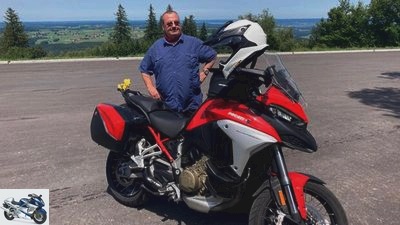
Yvonne Hertler

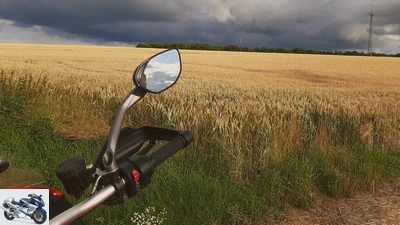


38 pictures

Yvonne Hertler
1/38
Eric, Gerhard, Wolfgang, Thomas and Simone were selected to test the new Ducati Multistrada V4 S..

Thomas Keller
2/38
Thomas covered 1,156 kilometers in the first week! The lucky one went on vacation with the Multi V4 S..

Thomas Keller
3/38
Tours in the northern Black Forest, Palatinate Forest, Middle Rhine Valley and on the edge of the Taunus were on the program.

Thomas Keller
4/38
In the week after the vacation, Thomas totaled 505 kilometers. The engine inspires him more and more and he is also impressed by the radar system.

Simone Helm
5/38
Simone covered 847 kilometers in the first week of testing the Ducati Ride Experience.

Simone Helm
6/38
At home, the test multi first got to know the ancestral Tiger. Simone: “I hate to say it, but the seating position is a little more comfortable on the Duc than on the Tiger Sport.”

Simone Helm
7/38
In the 2nd week of testing, it was intense on 2,321 kilometers.

Simone Helm
8/38
Simone: “Many thanks to my 8-person tour group who took me on an extended test drive into the Austrian and Slovenian mountains with the Ducati.”

Simone Helm
9/38
Multistrada V4 S in front of the memorial park “Italian Charnel House” in Kobarid, Slovenia. Unfortunately we had to cut the tower for our image format.

Wolfgang Weisenborn
10/38

Wolfgang Weisenborn
11/38
At the beginning of the first week of testing, Wofgang noticed that his iPhone 7 plus did not fit in the cell phone compartment on the tank.

Wolfgang Weisenborn
12/38
There is space for an external navigation system on the handlebars and Wofgang is happy about the on-board socket in the cockpit. “I still prefer because I don’t know; how much data volume mobile communications the integrated navigation system swallows up abroad.”

Wolfgang Weisenborn
13/38
Wolfgang dismantled the suitcases and attached a tank bag and a rear bag.

Wolfgang Weisenborn
14/38
And as a good luck charm he attached it “Woodstock” with cable ties on the rear luggage rack.

Eric Nehren
15/38
Eric covered 1,300 kilometers in the first week of testing. He is enthusiastic about the quickshifter and windshield, among other things.

Eric Nehren
16/38
His feedback: “Distance cruise control works well, menu navigation is easy to understand despite many functions.”

Eric Nehren
17/38
In the 2nd week of the test, Eric was mainly on the road, on asphalt there were only connecting stages.

Eric Nehren
18/38
Eric: “The multi is fun – a lot of fun! With appropriate protective equipment and driving experience, it has a lot of potential on slopes and easy terrain!”

Yvonne Hertler
19/38
Ducati and the readers met on June 18th at the MOTORRAD location in Stuttgart. The reader test machines were ready there.

Yvonne Hertler
20/38
Uwe Seitz, MOTORRAD editor-in-chief welcomed the readers.

Yvonne Hertler
21/38
Such an action does not take place without written material, but the readers did not sell their soul.

Yvonne Hertler
22/38
Andreas Kirchhoff, Service Area Manager at Ducati Motor, showed the participants of the Ducati Reader Experience how to adjust the height of the seat.

Yvonne Hertler
23/38
The menu navigation and the assistance systems such as the cruise control were also explained.

Yvonne Hertler
24/38
All of this happened right in front of the publishing house – unfortunately we couldn’t offer more romance.

Yvonne Hertler
25/38
A smartphone and the remote control key fit into the storage compartment on the tank.

Yvonne Hertler
26/38
At the end of the introduction, all participants had connected their smartphones to the Multi.
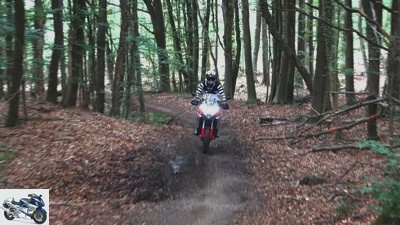
Gerhard Lohr
27/38
Gerhard was traveling alone in the Alps for the past week.
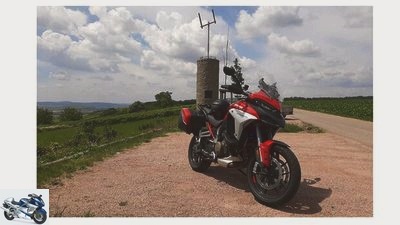
Gerhard Lohr
28/38
He particularly enjoyed the cultivated engine and its sovereign side.
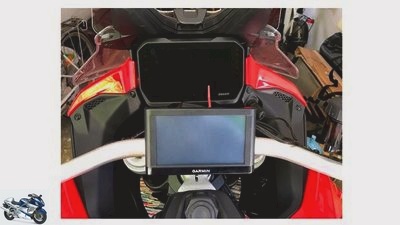
Gerhard Lohr
29/38
With an average of 6.5 liters, the consumption in the mountains is moderate for him.
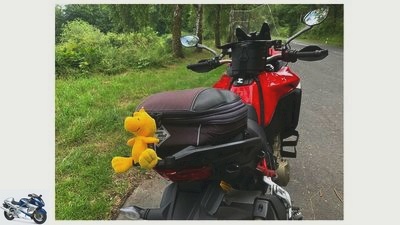
Thomas Keller
30/38
Thomas has experienced his 603 kilometers during the last few days, among other things, during an Eifel tour.
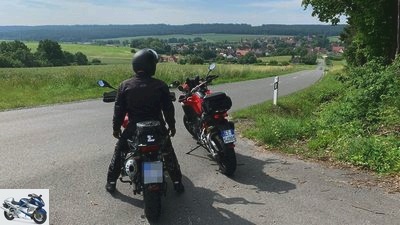
Thomas Keller
31/38
Here the multi was able to impress him with its great handiness.
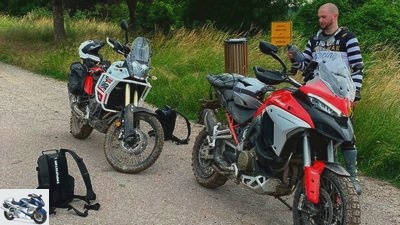
Thomas Keller
32/38
Even for the V4, he has only words of praise in the swarm of curves.
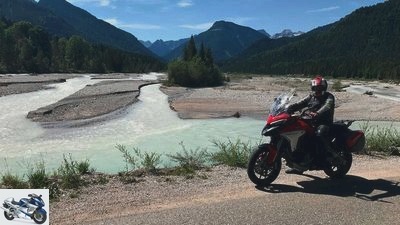
Eric Nehrens
33/38
Eric was more and more off-road, like last time, and draws a comparison with his BMW R1200 GS Rally.

Leonard Zirlik
34/38
Would the motorcycle be an option for you? Simone: “Yes! Great ergonomics, the 170 hp are incredibly fun and handling feels playful. I had an extremely good time with the Multi V4!”

Leonard Zirlik
35/38

Leonard Zirlik
36/38
Would the motorcycle be an option for you? Gerhard: “The Multi V4 is out of the question for me because the only weakness I have identified – namely the short range – is a real criterion for a frequent traveler like me.”

Leonard Zirlik
37/38
Would the motorcycle be an option for you? Thomas: “The Multistrada V4 S combines what I like about my two motorcycles very well. And if I had to limit myself to a motorcycle, it would be my first choice right now.”

Leonard Zirlik
38/38
Would the motorcycle be an option for you? Wolfgang: “Yes, the V4S would be an option for me as a new acquisition.”
motorcycles
Enduro
Ducati reader experience: test the Multistrada V4 S.
Ducati Reader Experience 2021
Test the Ducati Multistrada V4 S for 4 weeks
For the Ducati Reader Experience 2021, 5 MOTORRAD readers will each have a Ducati Multistrada V4 S Travel for 4 weeks & Radar available. We are looking forward to the reader test.
Dina Dervisevic
07/19/2021
Friday, June 18 in Stuttgart in front of the Motor Presse Stuttgart publishing house, which also includes the MOTORRAD editorial team: 5 Ducati Multistrada V4 S including suitcase were ready in front of the foyer for 5 selected MOTORRAD readers who received their very personal reader test Multi V4 S that day. Simone, Eric, Gerhard, Thomas and Wolfgang were welcomed by the MOTORRAD editor-in-chief Uwe Seitz. 3 colleagues from Ducati explained the special features of the new Multistrada V4 S and the details of the Travel & Radar package. Andreas Kirchhoff from Ducati showed the participants how the seat height can be adjusted, demonstrated the swinging pannier holders as well as the operation and menu navigation of the on-board computer.
Particularly long maintenance intervals
The new Multi shines, for example, with particularly long maintenance intervals of 60,000 kilometers, an oil change is only due every two years or after 15,000 kilometers. But even with its 170 hp it sets the standard in the travel enduro class, with Ducati emphasizing that the power output is gentle and always just right. And the new V4 with its twin pulse firing order should be reminiscent of a typical Ducati V2 and not be too loud. Particularly interesting in high summer temperatures: When the vehicle is stationary, the rear cylinder block of the V4 is deactivated so as not to additionally warm the driver. And during the journey, special winglets are supposed to direct a lot of fresh air and airflow to the driver’s legs.
Reader feedback test week 1
Simone

Leonard Zirlik
Simone (1.74 meters tall): otherwise drives a Triumph Tiger Sport 1050 (2014).
- Kilometers driven in test week 1: 847 km
- Test environment: country roads and autobahns
- Average consumption according to the on-board computer: 6.5 (average speed: 67 km / h)
City traffic: –
Overland traffic: The screw for adjusting the right side mirror is so tight that I cannot adjust the mirror. The seat feels like the seat heater is on, but it is definitely not on.
Highway: Blind spot warning works well on the right and left.
Ergonomics: Very comfortable seating position allows playful handling of the Ducati. Ergonomics is great, as if tailored to me. Handlebars, footrests, seat height of the low accessory bench – everything fits me and my 1.74 meters perfectly.
That surprised me: I actually find the blind spot warner helpful. Just set the dimmer.
That disappointed me: The tenacity of the screw on the right rearview mirror. I’m curious to see who can solve it in the end. I definitely don’t. Plus, it didn’t work out so well with the navigation. When my phone went to sleep, there was an error message on the connection.
Differences to the current motorcycle: I hate to say it, but the seating position is a little more comfortable on the Duc than on the Tiger Sport.
Other notes: My iPhone A5 with case fits very tightly into the cell phone compartment on the tank. Ingenious: the charging function is included!
Eric

Leonard Zirlik
Eric usually drives a Yamaha Tenere 700.
- Kilometers driven in test week 1: 1,300 km
- Test environment: country roads, autobahns, off-road
- Average consumption according to the on-board computer: on average 5.9 liters. Driving style hardly matters – basic consumption is quite high, but it hardly increases with brisk driving style.
City traffic: –
Overland traffic: The most comfortable touring bike I’ve ridden on the road, easily on par with the 2017 R 1200 GS. Engine over 3,500 rpm with very good torque, a bit choppy underneath. In my opinion, this is the difference to the BMW, which runs better at the bottom, but less at the top.
Highway: –
Ergonomics: Ergonomics great for touring, great weather protection. But: if you wear the trousers in your boots, the winglets shovel the rain exactly into your boots. But they serve their purpose very well – the air comes noticeably cool from below and not from the (massive) cooler.
That surprised me: The quickshifter is a dream. The windshield is awesome, for me (1.83m) at the lowest level there is a draft right in the face, at the top exactly above it, as you want it to be. One-hand adjustment is great! Distance cruise control works well, menu navigation is easy to understand despite many functions. Took a lot longer with my 2018 Africa Twin, even if it has significantly fewer functions.
That disappointed me: Connect doesn’t (yet) work with my Android phone, what a shame. Ducati has set a marker on the handlebars for the angle of inclination in the terrain, but unfortunately you cannot retrofit the mirrors sufficiently without adjusting their suspension, including brake and clutch levers, upwards … in other words: mirrors are unfortunately not suitable for off-road use. If I would buy a V4, it would unfortunately be without radar. The crankshaft housing urgently needs impact protection (polymer plate?) And the wind spoilers would not last for two days if I did not show consideration…
Differences to the current motorcycle:
Other notes: My girlfriend also felt very comfortable driving. She didn’t want to give up the Duc any more.
Gerhard

Leonard Zirlik
Gerhard (1.82 meters tall): otherwise drives a Ducati Multistrada 1200 (MY 2014).
- Kilometers driven in test week 1: 500 km
- Test environment: city traffic and motorway
- Average consumption according to the on-board computer: 7.8 l / 100 km.
City traffic: Suitcase quite wide, not ideal for winding through
Overland traffic: Armed with a reserve canister, I drove the range to zero kilometers and was then able to refuel 19.1l to the brim. The tank felt empty too. This means that the specification of 22 l tank content is incorrect or the range display is inaccurate.
Highway: Wind protection is good, even at 250 km / h. Very good pulling force, very high-performance engine. Driven 180 km / h with a suitcase without commuting – perfect.
Ergonomics: At 1.82 m tall, the seat height is too low for me, I would like to sit higher. The highest bench lock of the standard bench is already set.
That surprised me: The radar system works very well for both cruise control and even better for lane change assistance. A real advance in security. In addition, the winglets work very well, the cooling air to the driver’s leg is very good: Noticeable from 100 km / h in my motorcycle clothing and from 50 km / h in city traffic with shorts.
That disappointed me: With a moderate driving style, the fuel reserve began to glow at 250 kilometers, at 300 kilometers the range was then to zero. I would like more for a touring motorcycle.
Differences to the current motorcycle: Much easier to drive than my old Multistrada 1200 MY14.
Other notes: My smartphone got very hot in the compartment on the tank. Ducati Connect and Navi work well. It is impractical that you have to re-register after every short stop. An iPhone 7 fits in, but unfortunately my 7 plus doesn’t.
Thomas

Leonard Zirlik
Thomas (1.81 meters tall): otherwise drives a KTM 1290 Superduke R (2017) and a BMW R 1200 GS (2014).
- Kilometers driven in test week 1: 1,156 km
- Test environment: Mainly country roads and federal highways. Tours in the northern Black Forest, Palatinate Forest, Middle Rhine Valley and on the edge of the Taunus.
- Average consumption according to the on-board computer: 7.0 l / 100 km (The fuel consumption is high, but still acceptable for me in terms of power output. However, with a remaining range of 8 km, I only got 19.24 l in the 22 l tank.)
City traffic: Very inconspicuous or not intrusive, but still nice sound. Small turning circle for a motorcycle in size and therefore manoeuvrable in city traffic.
Overland traffic: Great pressure across the rev range; playful turning behavior paired with high cornering stability, which I have a lot of fun on narrow little streets with hairpin bends and on wide streets with large radii; in sport mode, when the front brake is released late on a bad surface, the front moves into motion; During breaks, I was often approached – mostly enthusiastically and enviously – about the multi.
Highway: I haven’t driven a lot on the Autobahn, always shorter sections. However, I was excited about the radar. It works perfectly and makes driving in the left lane in the convoy very relaxed. I also used the radar on the federal highways and in the city; also here: top!
Ergonomics: For me, the ergonomics fit perfectly. I wouldn’t change anything. I attached the pillion seat in the front position, which was the case with “Vaporizing” represents a pleasant contact for me.
That surprised me: Handiness and the quality of the radar system
That disappointed me: The GPS and I are not good friends yet. Unfortunately, the Sygic app does not have a motorcycle selection as it does for winding routes. After a break (with the ignition switched off), the smartphone must first be used again in order to re-establish the connection with the Ducati Connect app. It’s a bit annoying.
Differences to the current motorcycle: Better touring suitability than KTM with similar performance, the character of the V2 engine is modeled with better running smoothness. Compared to the BMW, the greater performance for fast laps on the home route with comparable ergonomics and handiness.
wolfgang

Leonard Zirlik
Wolfgang (1.79 meters tall): otherwise drives a BMW R 1200 GS Rallye (2018), a KTM 890 Adventure R and a KTM 690 Enduro R..
- Kilometers driven in test week 1: 300 km
- Test environment: Motorway 180 km, country road 90 km, city 30 km
- Average consumption according to the on-board computer: 6.5 l / 100 km (calculated: 6.7 l / 100 km)
City traffic: From the very first kilometer, the V4S impressed me with its very good ergonomics and amazing handiness.
Overland traffic: very handy chassis; the automatic suspension tuning is perfect, and can also be changed from creamy to sporty; enormous acceleration and nice draft; Driving noise not too loud and almost like a turbine at higher speeds.
Highway: Accelerating through is pure joy with the Quickshifter, which works perfectly upwards. The 170 PS engine output is definitely noticeable – you can easily move forward from 60 km / h to 250 km / h.
Ergonomics: The seat ergonomics fit perfectly straight away. The driver’s seat is comfortable – not too hard and not too soft. The rear-view mirror surfaces should offer a little more rear view.
That surprised me: The easy drivability from the first kilometer – great. So far I have not missed a radar-controlled distance cruise control, but together with the blind spot warning device, both are convincing additional equipment, especially on the motorway.
That disappointed me: The operating concept of the navigation via a mobile phone app is not yet fully developed, and it also requires a lot of battery capacity. I personally prefer a separate navigation device. And instead of the plastic case, I would use aluminum boxes as a top loader.
Differences to the current motorcycle: Advantages: Cultivated engine with sufficient power, better performance in the high-speed range. Disadvantages to the BMW R 1200 GS: no cardan; Disadvantages to the KTM 890 Adventure R: higher weight and design-related lower off-road suitability.
Other notes: Driving situation: three-lane motorway, right lane only trucks, middle and left lanes little traffic, long right-hand bend, driving speed approx. 220 km / h. Then a truck suddenly pulls from the right to the center at around 60 km / h. Action: Full braking from 220 km / h to 60 km / h in an inclined position with lane change, Multistrada reaction: the brakes are within the control range both at the front and rear, the regulation is noticeable, the Ducati remains absolutely stable, the cornering ABS works perfectly. Reaction from me: accelerated pulse increase to an estimated 190 bpm. Staying cool is everything.
Reader feedback test week 2
Simone

Simone Helm
Simone: “Many thanks to my 8-person tour group who took me on an extended test drive into the Austrian and Slovenian mountains with the Ducati.”
- Kilometers driven in test week 2: 2,321 km
- Test environment: country road, motorway (630 km)
- Average consumption according to the on-board computer: 6.1 6.5 l / 100 km
city traffic: I was now able to adjust the rearview mirror successfully.
Overland traffic: Tauern Pass, rain, cool at 9 degrees. The perfect time to try out the heated seats. But I had unplugged it because I suspected the electronics were defective, as the seat always feels hot. And now the passenger seat is blocked with a travel bag. However, the multi cannot help with that.
Played around with the buttons and finally discovered the sport mode, with which the machine sticks even tighter to the ground during sporty curve swing.
Noticed: The Multistrada copes very well with changing the road surface on partially very broken roads with holes and gravel.
Highway: Traffic jam on the motorway with an outside temperature of 24 ° C. The bum and thighs are boiling on it “Fire chair”. The heat comes from the engine, even without the seat heating switched on.
That surprised me: Even after almost 3,000 kilometers, the grippy Pirelli Scorpion Trail II tires still shine with a sufficiently deep profile. The windshield, which can be easily adjusted manually, is also great, although the lowest position is sufficient for me and offers optimal wind and rain protection.
That disappointed me: Seat heated up unpleasantly by the engine. Maybe this is due to the lower bench from the accessories range? I don’t read anything about hot benches from the other participants and they have the standard bench.
Due to the swinging case system, only both cases can be used. Here I would like to have a lock so that it is possible to drive with a suitcase. Driving modes do not include a separate rain mode, instead you can use the selected mode itself “wet road” to be chosen. Tip from top tester Karsten Schwers: “With Ducati, all riding modes can be freely configured as required. For example, if I want a clearly defined rain mode, I can just go over and do the “Urban”-Mode to mine “Rain”-Make mode (ABS and traction control at the highest level, engine power down, etc.)”
Differences to the current motorcycle: The smooth shifting up and down with the Quickshifter is great, which I would also celebrate with the Tiger. The usability of tour and sport modes is also an advantage. The hot bench is horrible, the Tiger doesn’t have it. Practical is the easy handling of the cases (which I don’t have for the Tiger), although I would prefer more robust cases (without paint) and fillable from above.
Eric

Eric Nehren
Eric: “The multi is fun – a lot of fun! With the appropriate equipment and driving experience, it has a lot of potential on the slopes and easy terrain!”
- Kilometers driven in test week 2: 600 km
- Test environment: forest and field paths with a lot of mud, country road when it rains
- Average consumption according to the on-board computer: 5.8 6.5 l / 100 km
terrain: Standing position with handlebars leaning forward to the mark is very good. Tank a bit wide, but bearable for what the machine should be able to do. Off-road ABS works well, I got traction control off as a matter of principle. As long as you maintain a little speed, the handling is very good, especially the chassis is convincing. Even with potholes and jumps, the fork does not hit through, but stops just before just short of, very good! In mud you shouldn’t be afraid of the performance, because even if you want to get out of a mud hole with a lot of clutch feeling, the motor has to stay on revs. But it’s just a matter of getting used to, as the Multi V4 can be dosed very well in Enduro mode. The Pirelli Scorpion Rally is a really great tire for mixed use. The rear tire has a little bit of lateral support off-road (which is not bad – it drifts well), but I hardly notice on the road that it is not a street tire – great! Cons: The mirrors. Due to the radar, fixed mirrors are installed which of course cannot be exchanged for folding mirrors so easily. Annoying: Although there is a marking on the handlebars for off-road-compliant inclination, unfortunately the mirrors can no longer be tilted back sufficiently in this position – so: Release the mirror including the brake / clutch lever and set it back to the street position, which partly has the effect of the inclined handlebar again destroys.
Overland traffic: Very safe to drive even in the rain, especially very tame in urban mode. Excellent weather protection on the upper body. Negative: The spoilers, which ensure cool air on the legs (which they also make very effective), unfortunately shovel water thrown up by the front wheel towards the shins when the road is wet – very disadvantageous with in-the-boot pants. But since most drivers wear their pants over their boots, it will be less of a burden.
Highway: First motorcycle that I enjoy driving on the autobahn, and that means something! Distance cruise control is ingenious, notices by means of indicators and angle of inclination when I want to overtake and accelerates out of motion.
ergonomics: Handlebars are great in the forward-tilted position, unfortunately not compatible with mirrors. Footrests too narrow and short for off-road use. The seat is extremely comfortable, but due to its width it made it a little difficult for me to put my foot close to the bike in the terrain – but it can be easily improved by moving my bottom – a matter of getting used to, because I would never change this sofa!
That surprised me: Not that it’s a surprise … but boy, does the front wheel like to go up!
That disappointed me: When it comes to the ergonomics of the mirrors, as a driver with an affinity for off-roading, I would actually be torn between doing without the ingenious radar pack in order to be able to mount folding mirrors. Likewise footpegs – Ducati shouldn’t cost much more than the narrow ones, but would result in many advantages and in my opinion no disadvantages.
Differences to the current motorcycle: Far superior tourer and athlete to the Tenere 700. The Tenere doesn’t like the motorway, it can drive on the road, but wants to hit the slopes and is also at home in mud and sand. The other way around, the Duc – loves the motorway and fast country roads, knows the slopes and can withstand terrain that is within the driver’s comfort zone. Experienced riders can do the same with the Duc as they can on the Tenere, but in my opinion off-road beginners should approach slowly.
Further notes (for use in the field): Floor pan, although it is the thicker OEM sheet metal, could be thicker and especially cover more of the crankshaft housing, which sticks out a long way and screams to be cracked by a stone. For the Tenere and Africa Twin, for example, there are also screw-on polymer covers that protect the housing from the roughest. Proper crash bars and hand protectors made of metal (and folding mirrors) are mandatory here and I would personally remove the plastic spoilers before they leave the next ruts or roots.
All the gripe aside: The multi is fun – a lot of fun! With appropriate protective equipment and driving experience, it has a lot of potential on slopes and easy terrain!
Gerhard
- Kilometers driven in test week 2: 250 km
- Test environment: city and motorway, few country roads
- Average consumption according to the on-board computer: 7.2 6.5 l / 100 km
city traffic: There are currently lots of construction sites and traffic jams in Munich. With or without a suitcase, driving through in a traffic jam is not easy due to the width of the vehicle. I think the heat dissipation of the engine in traffic jams is much better solved than with the previous models or the V4 Panigale. Display is great, shows calls well. The Sygic GPS navigation is also good.
Overland traffic: Cruise control and distance radar work perfectly, but I wouldn’t need them.
Autobahn: Topspeed 260 on the speedometer is great, but more range would be more important to me.
Passenger comfort: A helmet fits in the left case, but not in the right one. The passenger is really looking forward to the seat heating, which she can also switch on herself. Sizius ergonomics are very popular. Top wind protection, seating position and view for the front passenger. At 180 km / h, the passenger felt a strong wind on her right foot.
ergonomics: As a driver, I would like to sit higher. Maybe I’ll try the higher bench from the accessories range?
That surprised me: Subjectively, the Multistrada V4 is much quieter than the MTS 1200
That disappointed me: the short range. Without wanting to nag, I rate that as a real flaw. With suitcases and a passenger, we did not get beyond a range of 250 km. When the reserve starts to glow, the V4 shows 50 km remaining range. It’s like years ago with my 1098 and 848 and can regularly lead to breakdowns due to lack of petrol.
Other notes: The on-board socket is now sensibly located in the cockpit and not, as with the MTS 1200, near the battery. An external navigation system can be easily connected there. I still prefer it because I don’t know; how much data volume mobile communications it swallows abroad.
Thomas

Thomas Keller
Thomas: “Blipper works very well both ways. And the engine also inspires me more and more. Could get used to the bike …”
- Kilometers driven in test week 2: 504 km
- Test environment: country roads and motorways. I even included sections of the motorway in the tours. Unfortunately only after work tours.
- Average consumption according to the on-board computer: 7.2 6.5 l / 100 km
city traffic: Here I am using cruise control more and more frequently, which, thanks to the radar, makes driving through town much more relaxed.
Overland traffic: this is where the motorcycle belongs. Regardless of whether they are narrow or wide, have a good surface or are a bumpy road, the Multi V4 turns every country road into an experience. The lean angle is large and allows bold and safe cornering.
Highway: The Multi runs stably over the track. Even with the suitcases. The wind protection is absolutely fine for my height (1.81 m). Even at top speed. The height adjustment of the windshield is super easy and can be operated with one finger. What I have to emphasize again on the stages on the motorway is the cruise control with distance detection. I really like the system a lot, although I was skeptical at first. I haven’t been a fan of cruise control in the car either, because I usually had the feeling that the set speed never works. If you run up, you have to correct, if you want to overtake you have to accelerate anyway. Cruising speed set to 160 km / h and the system allows you to travel relaxed. If you run up, it brakes as far as necessary and then again as soon as possible “the way is clear” it gently accelerates again to the set speed. For me a real progress and a “Must have”.
ergonomics: Simply great ergonomics. Works well in most situations. Very comfortable even on longer stages. Nevertheless, I can also drive very actively and not only when I’m old “glob”-Form a line with the bike.
That surprised me: My helmet fits in the left case.
That disappointed me: What sometimes takes a long time and can be annoying is locking the steering lock. In sport mode, my bike tends to oscillate around its longitudinal axis when quickly driving over bumps. Maybe it’s just an imbalance on the front wheel. But it’s already getting your pulse racing.
Differences to the current motorcycle: Compared to the KTM, I usually have a higher speed on the Ducati, i. H. my feeling that I can get enough power as soon as I want to accelerate is almost 1,000 rpm lower with the KTM than with the Ducati. Except in sixth gear. The translation of the KTM is extremely long.
Other notes: Blipper works very well both ways. And the engine also inspires me more and more. Could get used to the bike …
wolfgang

Wolfgang Weisenborn
Gerhard: “The on-board socket is located in the cockpit and not, as with the MTS 1200, near the battery. An external navigation system can be easily connected there.”
- Kilometers driven in test week 2: 270 km
- Test environment: 260 km country road, 10 km city
- Average consumption according to the on-board computer: On-board computer 7.0 6.5 l / 100 km (calculated 7.2 l / 100 km, average speed approx. 57 km / h)
city traffic: The Multistrada V4S impresses with its well-balanced weight distribution. I was also impressed by the good-natured behavior when starting and turning, this also works optimally on steep uphill stretches.
Overland traffic: lively drive through the Wispertal, increased speed on the Ranselberg and the Pressberg uphill and downhill. The routes consist of alternating curves with medium and narrow radii. The possible and also driven speeds were in the range of 55 to 100 km / h. The V4S pleases with its very easy handling and shows no load change reactions. The tracking is extremely precise. The Duc is simply a pleasure to drive.
ergonomics: To increase the driving pleasure, I made the following adjustments in the 2nd week: Loosened the mirror on the right and adjusted it slightly differently, placed the front seat in the higher position and the pillion seat in the rear position, made the seat lock heavily powdered with graphite and made it passable. Air pressure adjusted (v. 2.4 bar / h. 2.7 bar), Garmin navigation system mounted on the handlebar, power is supplied via the switchable socket in the cockpit. The luggage cases were dismantled and a compact tank bag from Enduristan was installed. A rear pocket was also attached to the pillion seat for gummy bears and water bottles. Finally, I still have a lucky charm “Woodstock” attached to the rear luggage rack with cable ties. Everything fits now.
That surprised me: With the V4S, I could probably set new best times on my personal home routes. If only it weren’t for the race management. The engine, chassis, brakes, ergonomics and design are simply great!
That disappointed me: The seat lock was extremely stiff at the beginning. The key could not be withdrawn at times or only with force. The mirror mounting screws were glued in over the entire thread, this had the consequence that the thread in the handlebar bracket was released when the screw was loosened. And the factory smartphone connection and the navigation solution via app are still not the optimal solution for me.
Differences to the current motorcycle: I didn’t really miss the bearish draft of the R 1200 GS or R 1250 GS. And what about the cardan? Do you really need that??
Other notes: Saturday evening at the parking lot in front of the Wisperstube. The room was already closed, but there was one last milk coffee on hand. Some interested enduro and supermoto riders were also empty from the cup. First there were curious glances, then many questions about the technology of the four-cylinder, about fuel consumption, about the price, and so on. The result was an almost two-hour gasoline talk about enduros in general, about travel enduros in particular and about experiences on and with the motorcycle while traveling halfway around the world. As a result, the inevitable need to determine when driving home in the dark that the Duc’s cornering lights are also top-notch.
Reader feedback test week 3
Simone
- Kilometers driven in test week 3: 77 km
- Test environment: country road (after-work lap)
- Average consumption according to the on-board computer: 6.2 6.5 l / 100 km
Overland traffic: I have now issued the blind spot warning – I am irritated by the bright light in the rearview mirror.
Eric
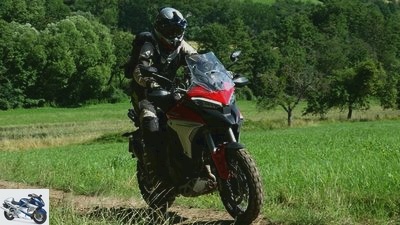
Eric Nehrens
Eric: “Compared to the R 1200 GS: more sporty, more manageable, more emotional. And similarly convenient. But also wants more attention when it comes to switching and consumes more.”
- Kilometers driven in test week 2: 400 km
- Test environment: forest and field paths with a lot of mud, country road when it rains
- Average consumption according to the on-board computer: 6.1 6.5 l / 100 km
Terrain: The V4 is difficult to convince to want to get out of the ruts, must be due to the steering head angle and wheel dimensions. Weight distribution somewhat less favorable than with the R 1200 GS – center of gravity higher – if it falls, it falls. I have to keep the engine running at at least 3,000 rpm so that I have enough leeway to get out of tricky situations. Coupling is not the lightest, but it is easy to dose. What I still can’t cope with today: the rear brake. The angle of the foot is not ideally adjusted for standing, but it is much more annoying that the pedal can be depressed very far without really getting a feeling for the desired effect. I don’t know whether this is desirable on the road, I’m not a good enough driver for that, but it really bothers off-road.
Overland traffic:
Positive compared to the R 1200 GS Rally: Better wind protection, seat slightly more comfortable, chassis better (despite electronically adjustable BMW Adv chassis, motor more lively when driving, more feeling for the front wheel – on the other hand, the GS looks rather spongy. Compared to the R 1200 GS rally negative: higher consumption (I hardly get it below 6 liters / 100 km), the engine is rather slack below 4,000 rpm and vibrates quite heavily, wider waist (with the BMW I get my feet closer to the bike, especially off-road on the ground).
Highway: Still brilliant! With the cruise control switched on, however – I noticed when driving in a convoy – when overtaking you should be at least in the middle of your own lane, otherwise it may be that the traffic is sorted incorrectly and heavily delayed.
Ergonomics: Sitting position perfect for me while sitting. To stand, the handlebars could be one to two centimeters higher. An optional flat, narrower enduro seat would be interesting. As well as you can tour on this one, it is unwieldy off-road. I would like footrests to be wider and longer – I have to stand bow-legged on this one so as not to rub my calves on the rear frame.
That surprised me: How different the V4S and R 1200 GS feel.
That disappointed me: That I have to give them back soon.
Differences to the current motorcycle: Compared to the R 1200 GS: more sporty, more manageable, more emotional. And similarly convenient. But also wants more attention when it comes to switching and consumes more.
Gerhard
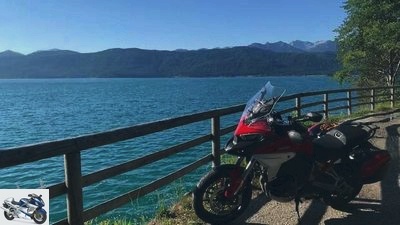
Gerhard Lohr
Gerhard: “On the country road, the engine shows its strongest side: sovereign overtaking, low tendency to wheely, very quiet and cultivated. Significantly better than the predecessor V2.”
- Kilometers driven in test week 3: 300 km
- Test environment: country road, solo alpine tour
- Average consumption according to the on-board computer: 6.5 6.5 l / 100 km
Overland traffic: On the country road, the engine shows its strongest side: sovereign overtaking, low tendency to wheely, very quiet and cultivated. Significantly better than the predecessor V2.
Highway: Top speed 260 on the speedometer is great, but more range would be more important to me.
That surprised me: For a joyride into the mountains, the Mulit V4 is the ultimate weapon for me: pulling through, braking and handling are all perfect. Here the consumption is more moderate at 6.5l.
That disappointed me: Nothing at all on the country road.
Differences to the current motorcycle: The semi-active chassis is significantly more stable than the conventional one in an MTS 1200 Standard. Real technical progress.
Other notes: The heated grips function is activated with buttons on the right-hand side and then the respective heating level is selected with the joystick on the left-hand side. Before that was enough “Click through” Off-low-med-high-off …
Thomas
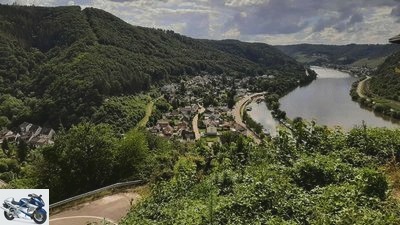
Thomas Keller
Thomas: “The interaction between the smooth-running, powerful engine, the inconspicuously working chassis, the low center of gravity with the great freedom of lean angle, the playful steering behavior and the high cornering stability made me very enthusiastic again.”
- Kilometers driven in test week 3: 603 km
- Test environment: Furthermore country roads and motorways, tour on the Moselle.
- Average consumption according to the on-board computer: 7.2 6.5 l / 100 km
Overland traffic: On the narrow serpentines on the edge of the Moselle, the motorcycle showed its great maneuverability. The interaction between the smooth-running, powerful engine, the inconspicuously working chassis, the low center of gravity with the great freedom of lean angle, the playful steering behavior and the high cornering stability made me very enthusiastic again.
Passenger operation: The ergonomics impressed my passenger. Sitting comfort, posture including knee angle suited her very well. Climbing on with the panniers mounted takes some getting used to, in contrast to unmounted panniers – like every other motorcycle in my opinion.
The motorcycle would be an option for me because: it lives up to its name. It fits all – paved – roads. And it does its job very well. I didn’t want to test off-road use. As I’m not an off-road rider, I didn’t want to start out with a borrowed motorcycle. She already has mass. And to master this to some extent in the field is not that easy for me to present.
That surprised me: The versatility of the motorcycle. The power output is very even and therefore almost unspectacular. A look at the TFT display, which is successful for me, shows the reality. And for me it usually deviated very strongly from the perceived speed.
That disappointed me: The locking of the steering lock partially worked only after the third attempt. I.e. the ignition is switched on and off again until the lock works despite the full stop. Relief of the front wheel and slight, minimal, slow movement of the handlebars did not help either. GPS and Android mobile phones have connection problems more often. The driver’s seat heats up when driving, just like in the previous model.
Differences to the current motorcycle: The Multistrada also has the virtues of the BMW GS. And that with a big plus in performance. However, I have the feeling that this comes into effect very late and therefore plays a subordinate role in most situations on the country road. But woe if you let go.
Other notes: After the Multi stood on the side stand during a stopover in the rain, water penetrated the left case. The right suitcase was dry. Except for the legs “saut” the Multistrada rider and pillion less one than my two motorcycles.
wolfgang

Wolfgang Weisenborn
Wolfgang: “I took off the suitcase and attached a tank bag and tail bag. And as a lucky charm, Woodstock is attached to the rear luggage rack with cable ties. Everything fits now.”
- Kilometers driven in test week 3: 600 km
- Test environment: 240 km motorway, 340 km country road, 20 km city
- Average consumption according to the on-board computer: on-board computer 6.3 6.5 l / 100 km (calculated 6.5 l / 100 km, average speed approx. 57 km / h)
City traffic: City traffic and through town traffic at 50 km / h in third gear go great, nothing jerks and the engine runs smoothly and smoothly. The Quickshifter works very well when upshifting, better than with the BMW GS, when downshifting the automatic gearshift of the KTM 890 is the measure of all things.
Overland traffic: On a longer country road through the Black Forest, I tried out the various suspension adjustment options. It is very easy to always find the optimal setting, from sloppy gentle to sporty hard, the range is impressive. If you are looking for the right suspension setting without trying too much, the automatic suspension adjustment is also very successful.
Ergonomics: The ergonomics fit. The main stand works with little effort. The side cases are easy to put on and take off. For longer journey stages of 250 km or more in a row, I would have liked a somewhat tighter seat. The keylessgo is annoying with long opening times and even longer closing times.
The motorcycle would / would be out of the question for me because: The V4S doesn’t seem to have any technical disadvantages. I don’t miss a cardan. I haven’t driven it off the road yet. For off-road routes, however, it would be a shame for me.
That surprised me: The all-rounder qualities of this 4-cylinder sport-touring-travel-enduro are still surprising to me.
That disappointed me: I still find the DUCATI-Connect in connection with the Sycic navigation to be immature and cumbersome to handle.
Differences to the current motorcycle: I did not find any major disadvantages compared to my current motorcycles. The exception is the lower off-road suitability. But you / women know that beforehand.
Other notes: The last week is going to the Alps, the anticipation is great.
Reader feedback test week 4
Simone

Simone Helm
Simone: “I am frightened by how easy it is to drive 170 hp. Always had respect for so much performance.”
- Kilometers driven in test week 4: 405 km
- Test environment: country road
- Average consumption according to the on-board computer: 6.9 6.5 l / 100 km (only driven in sport mode)
Overland traffic: She needs more fuel in sport mode, but this is definitely the most fun on the country road.
Ergonomics: As already noted in test week 1, the ergonomics are great and the seating position is probably so comfortable thanks to the narrow bench.
That surprised me: The logic of the low beam display was not fully understood by me. Indicator light in the display on when the engine is off: more light. Indicator light in the display on when the engine is on: less light. When driving, I therefore made sure that I turn off the indicator light for the dipped headlights.
That disappointed me: On the last trip she scared me with a red warning message. The multi reported that the rear wheel was only 0.0 bar. After switching it off and on again, the shock was over.
Differences to the current motorcycle: I am frightened by how easy it is to drive 170 hp. Always had respect for so much performance. I am now looking forward to the direct comparison to my 125 hp.
Price-performance ratio: If you are into the fact that 90 percent is electronically adjustable, you can find the high price justified. I myself am a fan of manually adjustable items and would not want to pay the extra price for a lot of electronics or for seat heating. The chassis and modes are really great and definitely worth the money.
For me personally, the price would be too high because I would not use a lot of what it offers and thus my willingness to pay for it decreases.
Overall rating of the motorcycle (school grade): 2
Would the motorcycle be an option for you? Yes! Great ergonomics, the 170 hp are incredibly fun and handling feels playful. I had an extremely good time with the Multi V4! The only thing that scares me is the hot engine fumes under the lower accessory seat. The price is also a size too big for me.
Eric

Eric Nehren
Eric: “If I ever wanted to buy a motorcycle of this type, the V4S would have good cards. Compared to the GS, I find it sportier and a little more exciting, especially on the road, for which both motorcycles are primarily designed.”
- Kilometers driven in test week 4: around 300
- Test environment: 80 percent country road, 20 percent motorway
- Average consumption according to the on-board computer: 6.1 l / 100 km
Urban traffic: Heat development barely noticeable, ventilation does its job excellently!
Overland traffic: Rear brake like very much. The fact that it is not so good off-road for me could probably be changed by adjusting the position tone.
That surprised me: How quickly the four weeks went by with her and how quickly I got used to her. And: that consumption does not change significantly when you drive faster.
That disappointed me: The basic consumption is too high for me. Relaxed driving is not really reflected in the balance sheet.
Differences to the current motorcycle: To compare it with the Tenere 700, even if the comparison is of course lame: In my opinion, the T7 follows the thoughts “What does a travel enduro really need?” and the multi rather the approach “How close can you bring a sports tourer to a travel enduro?” Both interesting approaches, both very successful in execution, but both for different target groups / applications, even if there are overlaps.
Price-performance ratio: Certainly justified for the technology, but for me personally, especially with regard to regular use on gravel, too high to be considered – unfortunately you can’t have everything.
Would the motorcycle be an option for you? If I ever wanted to buy a motorcycle of this type, the V4S would have good cards. Compared to the GS, I find it sportier and a little more exciting, especially on the road, for which both motorcycles are primarily designed. Only the consumption is a real minus point, which unfortunately can hardly be glossed over.
Gerhard

Gerhard Lohr
Gerhard: “Display, use of driving aids and electronics at the top level and significantly better than the previous model.”
- Kilometers driven in test week 4: 1,200
- Test environment: country road, city and a bit of enduro
- Average consumption according to the on-board computer: 7.1
That surprised me: During an off-road use was in the mode “Enduro” hazards. Here I was pleasantly surprised at how radically the chassis, ABS and DTC are changing. For me, due to the weight of the vehicle, off-road use would be limited to dirt roads. For steep driveways, tree crossings, etc. I don’t have the experience with a large enduro. Here I prefer my 100 kg beta.
That disappointed me: Only the short range; with a remaining range of 12 km, according to the on-board computer, I couldn’t refuel more than 19 liters.
Differences to the current motorcycle: Display, use of driving aids and electronics at the top level and significantly better than the previous model.
Other notes: After 1,300 km the engine oil level was at its minimum and it had to be topped up.
Price-performance ratio: Grade 3 – innovative technology, electronics and the most powerful motor in this class.
Overall rating of the motorcycle (school grade): 2
Would the motorcycle be an option for you? The Multi V4 is out of the question for me because the only weakness I have identified – namely the short range – is a real criterion for a frequent traveler like me. And that’s exactly where I would want to use the motorcycle.
Thomas

Thomas Keller
Thomas: “In the 4 weeks of testing with the Multi V4, I mostly took the longer and always the nicer route because riding the motorcycle was so much fun.”
- Kilometers driven in test week 4: 488
- Test environment: Small country roads and errands.
- Average consumption according to the on-board computer: 7.2 l / 100 km
City traffic: The width of the handlebar and that of the attached case are roughly the same. Winding through with suitcases is still an exciting thing because of the similar height with many car exterior mirrors. Otherwise, the Ducati is not a petite motorcycle. So she can’t keep up with a scooter in the city. But she doesn’t need that for me either. In my opinion, it is ideal for swimming confidently in city traffic.
Overland traffic: Last week, all kinds of country roads were a lot of fun with the Multi V4. Set touring mode on poorer roads and sport mode on good roads: you don’t need more effort on the motorcycle to get a lot of driving pleasure. Even when it rains I have the attitude “Touring mode” given a very secure feeling.
Ergonomics: The tank is kept nice and narrow to the bench, which results in a comfortable posture for me.
Other notes: In the 4 weeks of testing with the Multi V4, I mostly took the longer and always the nicer route because riding the motorcycle was so much fun.
Price-performance ratio: 2
Overall rating of the motorcycle (school grade): 2
Would the motorcycle be an option for you? The Multistrada V4 S combines what I like about my two motorcycles very well. And if I had to limit myself to a motorcycle, it would be my first choice right now.
wolfgang

Wolfgang Weisenborn
Wolfgang: “So far I have preferred to drive travel enduros with one-, two- or three-cylinder engines. The Ducati Multistrada V4S convinced me technically so much that a V4 cylinder is also conceivable as a drive source for me.”
- Kilometers driven in test week 4: 984
- Test environment: motorway 240 km, country road 710 km, city 34 km.
- Average consumption according to the on-board computer: on-board computer 6.1 l / 100 km
City traffic: The handiness in city traffic, also for two, is convincing. The heat build-up when creeping is unpleasant. The winglets attached to the fairing are certainly more effective at high speeds than in slow city traffic.
Overland traffic: When cornering with pleasure in speed ranges between 3,000 and 6,000 rpm, a certain flow feeling arises relatively quickly due to the pleasant engine characteristics, great.
Highway: Radar and distance cruise control show their positive sides here again. At first I thought I don’t need that, now I think these features are really successful and wonder why not all large travel mopeds have them.
Passenger operation: The favorite pillion of all finds the seating comfort quite pleasant for short journeys up to 100 km. With the suitcases mounted, however, there was too little space, especially for her legs. Getting on and off with the suitcases mounted led to involuntary gymnastics insoles. The pillion seat bench still offers optimization potential in terms of long-distance comfort, and the elevated seating position in the head area leads to strong turbulence.
Ergonomics: The successful ergonomics create a sense of well-being from the first kilometer. I only make compromises because of the somewhat limited space available when traveling with a passenger.
That surprised me: So far I have preferred to drive travel enduros with one-, two- or three-cylinder engines. The Ducati Multistrada V4S convinced me technically so much that I could also imagine a V4 cylinder as a drive source.
That disappointed me: That I had to return the V4S after 4 weeks of intensive testing …
Differences to the current motorcycle: I did not find any major disadvantages compared to my current motorcycles. With the overall conception of the Multistrada V4S, however, I could imagine a little more adventure feeling.
Other notes: With the Multistrada V4S with its magnificent V4 engine, Ducati immediately achieved a technically convincing, big hit. Perhaps Ducati is establishing a new motorcycle category with the V4S – that of the V4-cylinder sports touring travel enduro’s.
Price-performance ratio: I think the price-performance ratio is appropriate in view of the technology offered.
Overall rating of the motorcycle (school grade): Overall very good motorcycle.
Would the motorcycle be an option for you? The V4S would be an option for me as a new acquisition. I would like the following improvements: Possibility to mount an external navigation device over the dashboard, aluminum case as a top loader in connection with the original case brackets and their lateral mobility, more stable engine protection, larger footrests, rotatable similar. the Pivotpeggs, tank compartment in front of the tank lid with space for larger cell phones, no keyless go, starting and locking analogously with an ignition key, larger storage compartment under the pillion seat, for tools, medipack, safety vest, etc…
Related articles
-
Reader test ride Ducati Scrambler 1100 Special
Painted Buls 54 pictures Painted Buls 1/54 Andrea has had a driver’s license for a year and drives a KTM 390 Duke. Black Head 2/54 Andrea is on tour with…
-
Top test Ducati Multistrada 620
Artist motorcycles Top test Ducati Multistrada 620 Top test Ducati Multistrada 620 Hidden size Just a mid-range motorcycle from Ducati or a real…
-
Test & technology: Endurance test interim balance of the Ducati Multistrada 1200 S
Jahn motorcycles test &Technology: Endurance test interim balance of the Ducati Multistrada 1200 S Endurance test interim balance of the Ducati…
-
Top test Ducati Multistrada 1100
Gargolov motorcycles Top test Ducati Multistrada 1100 Top test Ducati Multistrada 1100 Turboprop Clear the start for the greatest air-cooled Ducati of…
-
Top test Ducati Multistrada 1000 DS
motorcycles Top test Ducati Multistrada 1000 DS Top test Ducati Multistrada 1000 DS Euphorisiac The Multistrada promises exciting curve fun on all…
-
Intensive test Ducati SuperSport S
Rossen Gargolov motorcycles Super athlete Intensive test Ducati SuperSport S Ducati SuperSport S in the intensive test Compact, light and a wonderful…
-
KTM Reader Experience 2021: Nine readers test KTM
@dnbuchi_media 26th pictures KTM 1/26 Nine lucky winners were invited by KTM to ride a few Dukes to the Grossglockner on a fantastic high alpine tour….
-
Ducati Reader Experience – 15 readers test the Diavel for 2 days
Thomas Schmieder Sports & scene Events Ducati Reader Experience – 15 readers test the Diavel for 2 days Ducati reader experience Ridden the devil for a…
-
Zero Reader Test Ride 2020: Readers test Zero SR-F and SR-S
Volker Rost 20th pictures Volker Rost 1/20 Off to new shores: none of the participants has ridden such an electric motorcycle before. Volker Rost 2/20…
-
Comparison test Ducati Hypermotard old against new
Artist 22nd pictures jkuenstle.de 1/22 Ducati Hypermotard 1100 Evo (old) and Ducati Hypermotard 821 (new). jkuenstle.de 2/22 Ducati Hypermotard 821….